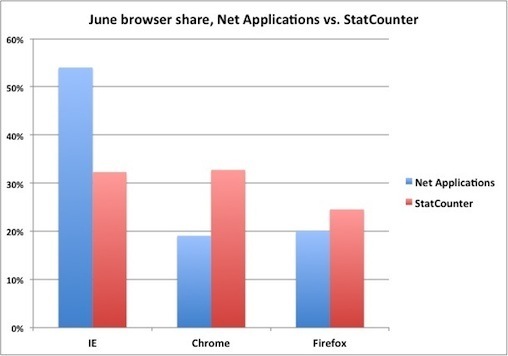The two most-cited browser tracking firms reported significantly different results for June on Sunday, with one claiming Microsoft's Internet Explorer (IE) easily maintained its No. 1 spot as the other said Chrome extended its lead over IE.
U.S.-based Net Applications said that IE accounted for 54% of all browsers used in June, head and shoulders above Chrome's 19.1% and Mozilla's Firefox, which came in second with 20.1%.
Net Applications calculates browser usage share by tracking unique visitors to approximately 40,000 Web sites that the company monitors for clients.
Irish metric company StatCounter, however, reported wildly different numbers.
According to StatCounter, Chrome was the planet's most popular browser for the second straight month with a share of 32.8%. IE, meanwhile, climbed to 32.3%, while Firefox -- in the third spot by StatCounter's estimate -- fell to 24.6%.
StatCounter tallies page views, not unique visitors, for approximately 3 million websites and unlike Net Applications does not weight the results by each country's pool of online users.
The two companies' browser share numbers have come under scrutiny recently as each has defended their methodologies against critics and as Google's top executive for Chrome claimed his browser was the world's most popular.
The differences between Net Applications' and StatCounter's estimates were across the board.
While Net Applications had IE flat in June compared to May, StatCounter said its share increased by two-tenths of a point. For Chrome, Net Applications reported a decline of half a point, but StatCounter had Google's browser boosting its share by four-tenths of a percentage point.
Firefox climbed by a third of a point in Net Applications' tracking, while StatCounter said the browser dropped a full percentage point.
Mozilla's browser was the only one of the top three with share numbers within spitting distance in both reports: The difference between Net Applications' and StatCounter's estimates for Firefox was just 4.5 points.
IE's and Chrome's numbers were 21.7 and 13.7 points different, respectively.
Even the firms' results for the four supported versions of Internet Explorer -- IE6, IE7, IE8 and IE9 -- were contrary.
IE6, the 11-year-old browser that Microsoft has been trying to bury for years, accounted for 11% of all copies of IE in use last month, according to Net Applications. StatCounter, however, put IE6's part at just 1.8% of all IE, or less than one-sixth as much.
Their calculations of IE9, the only edition that Microsoft has touted when it does comment on browser share, were also mismatched: Net Applications said IE9 was 33.3% of all copies of IE, but StatCounter reported IE9's share as 51.1% of all Microsoft browsers.
The difference between the two measurement vendors' tallies for IE6 highlighted the way each comes up with their estimates.
Because Net Applications weights its results by country -- using the CIA's 2009 data on the world's population of Internet users -- it counts each Chinese user as more important than average. That's because it, like all Western tracking firms, has trouble accurately monitoring browser usage in China.
If Net Applications' data shows China's share of the world's users is only a third of what the CIA calculates, then the company would count each Chinese user's browser three times.
(According to the CIA, in 2009 China's online population represented 21.4% of the world's Internet users, while the U.S. -- the only other country in double digits -- accounted for 13.5% of the planet's online users.)
It's no coincidence that China is a bastion of IE6 users, and that Net Applications, what with its weighted calculations, believes the aged browser is run by 6% of the world's Internet users, and by more than one-in-every-ten IE user.
Among their few points of agreement, Net Applications and StatCounter both reported a slow uptake of Firefox 13, the version that launched June 5. According to Net Applications, the new edition accounted for 30.7% of all Firefox copies used last month; StatCounter said Firefox 13's share of all Mozilla browsers was 33.6%.
Both numbers were considerably lower than the share that a new Firefox usually musters a month after its introduction.
Mozilla has blamed an emergency update that was released June 15 for the slow upgrade tempo.
Net Applications and StatCounter also agreed on the positions of Apple's Safari and Opera Software's Opera on the desktop, which were ranked by both as the No. 4 and No. 5 browsers, respectively.
Safari garnered 4.7% in Net Applications' data, 7% in StatCounter's; Opera's share was measured at 1.6% by Net Applications and 1.8% by StatCounter.






